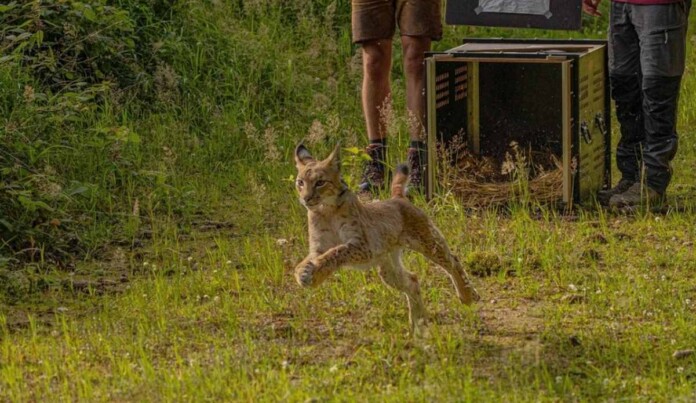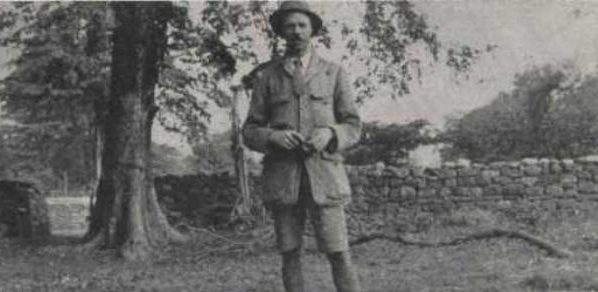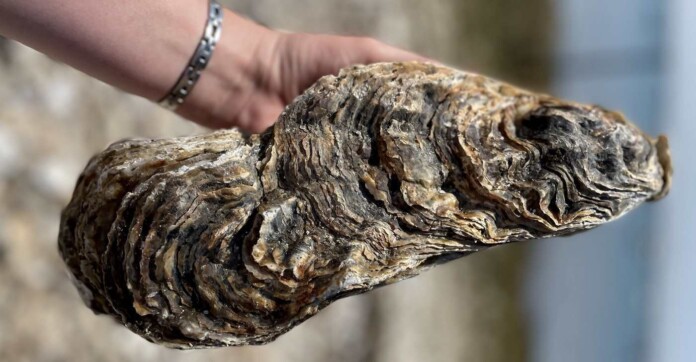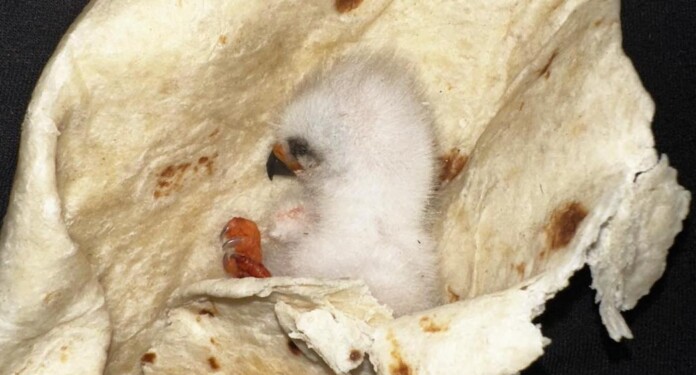6 years ago today, Civil Rights leader and Congressman John Lewis’ body was carried across the Edmund Pettus Bridge in Selma with a military guard of honor, the same bridge where 55 years earlier he had been violently beaten by police for his participation in non-violent protest. READ a bit more about the service for this famous leader… (2018)
K9 Officer Rescues Lost Non-Verbal Child by Following the Boy’s Scent in Reverse to Find His Home

In North Carolina, the Monroe County Sheriff’s Office received a call that a child was wandering alone on the road on July 7th.
Dispatching an officer to the Waxhaw Indian Trail Road, the child was located and secured, but being autistic and non-verbal, the officer had no idea where the boy had wandered away from.
Being that the responder was a K-9 Unit, and was working alongside his trusty 1-year-old bloodhound Remi, Deputy B. Belk utilized the dog’s incredible sense of smell to “reverse” the normal scent tracking process to find the boy’s home.
“Normally, [scent dogs] track from where a person left to try to find where that person is currently. This time we were doing it reverse,” said Lieutenant Public Information Officer James Maye to CNN.
“As many of our followers know, bloodhounds use scent articles to track. To obtain a scent article that would help identify the child’s home, Deputy Belk used a piece of sterile gauze to collect the scent from his forearms and the back of his neck,” a statement from the Sheriff’s Office said.
“The scent article was given to Remi, who then successfully tracked backwards for approximately a half mile before locating the child’s home in a nearby neighborhood.”
RESCUE DOGS NEAR AND FAR: Missing Toddler Found Sleeping in Woods with Dog as A Pillow After Walking 3 Miles Barefoot
When arriving, Deputy Belk found the garage door ajar and determined that the child left in a secretive manner and that no negligence of a criminal level had taken place. The parents were understandably grateful to see their son and Belk, who offered a series of “tips” on how to prevent such things from happening again.
Lieutenet Maye explained the technique of reverse tracking would now be implemented in the training curriculum for K-9 officers.
MORE STORIES LIKE THIS: Dog Runs Four Miles to Get Help for Owner Who Crashed Car into Oregon Ravine
“I’ve been around for 10 or 12 years. I’ve never heard anything like this being done. It’s not something that these guys train on normally, but it is something they’re going to instill in training from here on out,” Maye said.
SHARE This Quick-Thinking Officer And A Happy Ending To A Story Of Potential Heartbreak…
German Zoo Honors Little Lynx’s Wish to be Free After Repeat Escape Attempts
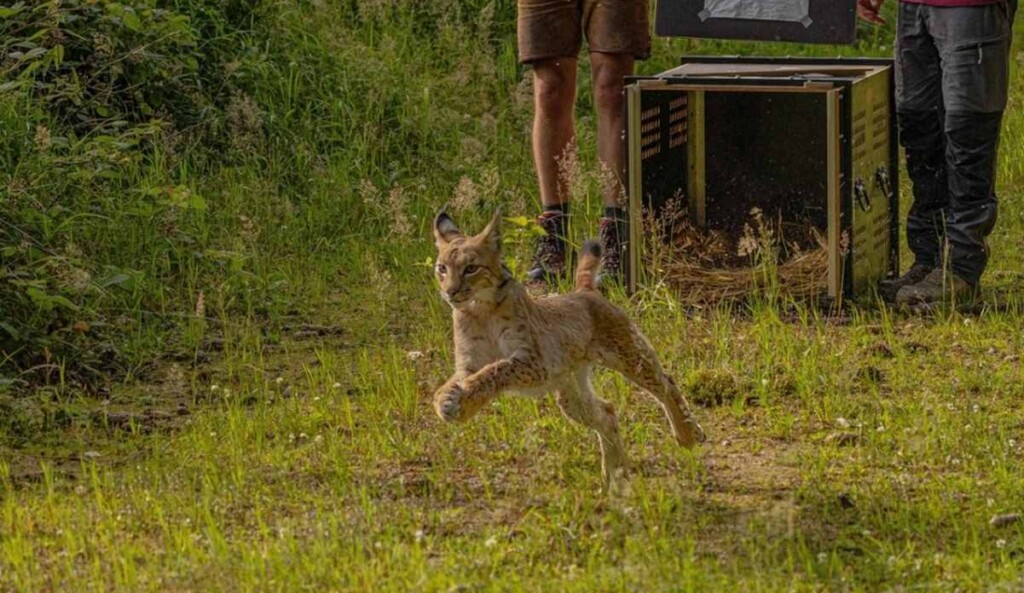
Despite being brought up in the Nuremberg Zoo a young Carpathian lynx named Chapo was born to be wild.
Respecting his wishes, the German zookeepers abandoned their intention to raise him to eventually contribute his genes to a vital captive breeding program and release him into the wilds of Germany.
Now residing in the forests of Saxony, he joins a steadily growing population of wild lynx across Germany and Switzerland that are slinking back across the acreage they prowled long ago.
The Carpathian lynx is a subspecies of the Eurasian lynx, which while being listed as endangered on the IUCN Red List, is nevertheless extinct across large swaths of its former habitat.
A further subspecies, the Iberian lynx, is thriving and growing across Portugal and Spain after 2 decades of heroic, intense conservation work. In Germany however, there are only 190 lynx roaming mainly in the Harz Mountains, and the Bavaria and Rhineland-Palatinate.
Chapo was one year old, when, as a captive-born cat, he was taken to a breeding facility in the Harz Mountains. The first thing he did, despite growing up in a zoo, was to leap over the enclosure fence.
He was quickly caught but his wanderlust was evident, the Sunday Times reports.
“He kept looking for ways out of the enclosure and found it difficult to settle down,” Saxony’s wildlife authority said in a statement. “This showed that the young lynx was better suited to being released into the wild.”
According to the Times, experts from the Linking Lynx network had identified Chapo as shy and suitable for reintroduction while he was at Nuremberg, leading keepers to maintain minimal contact with him, feed him only game meat, and place him in the largest enclosure.
YOU MAY ALSO LIKE: Camera Catches Sighting of a Tiger with Cubs for First Time in 10 Years, Raising Hopes for Species in Thailand
Two weeks ago, he bounded out of his crate, stopped to sniff the wind and catch his bearings, then disappeared into the forest—GPS collar firmly latched about his neck.
MORE WILDCAT NEWS: Rare Species of Feline Dubbed the ‘Original Grumpy Cat’ Found Living On Mount Everest
He joins three other lynx to be reintroduced this year, all of whom have “graduated” from hunting rabbits, to hunting foxes, to hunting deer. Despite being the third largest land predator in Europe, the lynx is seldom seen and poses no threat to livestock.
Recently, the Saxon government detailed that Nova and Luna were recorded as being only a hundred meters or so apart, and “it cannot be ruled out that they met.”
SHARE The Dream Of This Little Lynx Finally Fulfilled…
Blood Test That Detects Sepsis in 10 Minutes by Squeezing Blood Cells – Hailed as ‘the Holy Grail’


A life-saving blood test that can detect sepsis in under ten minutes by squeezing white blood cells could be available in as many as 11 US states by the end of the year.
While you won’t hear many news headlines about sepsis, US researchers have hailed the development as one of the most important breakthroughs in modern medical history and a “turning point” in the fight against one of the world’s deadliest diseases.
The test works by forcing a small amount of blood through a tiny tube to see if the white, immune-fighting cells change shape.
White cells in sepsis-affected patients are softer and more squishy than those in healthy people and become flattened and elongated under pressure. The more elongated the cells a patient has, the more likely they are to have sepsis.
Measuring cell shape to spot sepsis isn’t new, but the process has previously taken up to two days and yielded mixed results.
Until now, scientists have had to scrutinize and count the number of deformed white cells themselves using a microscope—a laborious process that has led to numerous wrongful or missed diagnoses.
“Sepsis is notorious as the ‘silent killer’ because it is so easily missed early on, when a patient’s symptoms can often be mistaken for other less serious illnesses,” said Professor Michael Atar, a British-based scientist and lecturer at New York University, dubbed “Mr. Sepsis” by the medical community.
“Rapid diagnosis and treatment is crucial to a good outcome, but there has never been a single, reliable diagnostic test available to doctors, costing precious time and people’s lives.
However, the IntelliSep test detects microscopic deformities using an ultra-high-speed camera that can capture over 500,000 frames per second.
The images are then analyzed by a state-of-the-art, AI-powered computer that tallies up the misshapen white cells in a matter of minutes and provides a digital reading with an average accuracy rate of 97%.
Cytovale, the Silicon Valley firm behind IntelliSep, for whom Professor Atar has been a lead investor and consultant for the past decade, describes the test as “genuinely groundbreaking” with the potential to save millions of lives each year.
Unlike other claimed breakthroughs that have never progressed beyond medical trials, IntelliSep has already been approved for use in the US by the FDA.
FURTHERMORE: Teens Say They Have New Proof for 2,000-Year-Old Mathematical Theorem, a Method Scholars Thought Impossible
It is currently in use at a hospital in Louisiana and will be rolled out to 10 other US hospitals by the end of 2024.
“Cytovale’s IntelliSep device is, by any objective measure, the ‘holy grail’ that the medical community has been so desperate to find,” Atar told reporters from his London home. “The technology behind it is genuinely groundbreaking and it has the real-world, tried-and-tested potential to save millions of lives, year on year, across the planet.”
YOU MAY ALSO BE INSPIRED TO KNOW: Cervical Cancer Trial Hailed as ‘Remarkable’ After 35% Reduced Death Rate Using Simple Intervention
Sepsis, or blood poisoning, kills one person every three seconds, and 11 million annually— more than breast, prostate, and bowel cancer combined. It is most commonly caused by an abnormal immune reaction to a bacterial infection from a wound, either internally or externally, which leads to an inflammatory response that makes things worse, not better.
White blood cells that normally work to protect the body from harmful bacteria overreact and start destroying healthy cells instead. If it is not diagnosed and treated immediately, usually with antibiotics, it can lead to organ failure death in as little as 12 hours.
MORE MEDICAL BREAKTHROUGHS: Lung Cancer Drug Elicits Unprecedented Results in New Trial
Until now, there has been no rapid and reliable diagnostic test that has undergone successful medical trials and received regulatory approval.
Doctors have instead been forced to rely on the presence of secondary symptoms, like high blood pressure and heart rate, to make a calculated guess if a patient with an infection could be at risk of or is suffering from sepsis.
SHARE News Of The Holy Grail Of Tests To Stop A Death Every 3 Seconds…
City Experiments with Reusable Cups at Starbucks, Taco Bell and 30 Other Restaurants–with Return Bins all Over Town

A consortium of small firms is creating a renewable revolution within the boundaries of a small city in Northern California, which will be the testbed for a use-and-return concept for fast food drinks.
Around 50 billion disposable drink cups are used every year in the US, but in the city of Petaluma, we will see if Americans have the discipline to reduce this footprint.
The city numbers around 60,000 people, and will participate in the Reuseable Cup Project. The aim is to furnish 30 local restaurants, from Starbucks to Taco Bell, with identical, durable, plastic drink cups, which customers and diners can use and then either leave on the table, or deposit in a network of dropoff bins around the city.
NextGen Consortium, which is led by the Center for the Circular Economy at Closed Loop Partners investment firm, asked the city government for help identifying partner restaurants, while a firm called Muuse will provide professional cleaning and distribution services to redeliver the cleaned cups back to the locations.
“What they’ve told us they like about Petaluma is that there’s already a spirit of sustainability in Petaluma and [an] interest in trying to reduce the amount of waste that we’re creating collectively as a city,” Patrick Carter, assistant of the city manager who oversees the program, said in a phone call with FOX Business.
“They liked the combination of kind of a denser downtown, more businesses together that are serving these drinks, these beverages, but with a smaller population.”
Located between Santa Rosa and San Francisco, Petaluma’s residents will not be charged a penny more for their drinks, and are only asked to drop them off in one of the network of bins when they are finished. A map showing the locations of the bins can be found on the project website.
MORE PROGRAMS LIKE THIS: Washed up Hi-Tech Tracker Buoys Brilliantly Redeployed to Protect Turtles from ‘Ghost Nets’
Along with reducing cup waste, it should also reduce the throwaway hot drink sleeves, since the cups themselves are more durable and less conductive to heat.
A three-month trial starting on August 5th and running into November will provide NextGen the data they need to understand if such a program can be used in larger cities.
SHARE This Much-Needed Action Plan To Green The Take Away Beverage Industry…
“Don’t be ruled by fear or futility. The future rests on what we do now.” – Joan Halifax
Quote of the Day: “Don’t be ruled by fear or futility. The future rests on what we do now.” – Joan Halifax
Photo by: ©GWC (Santa Barbara County, California)
With a new inspirational quote every day, atop the perfect photo—collected and archived on our Quote of the Day page—why not bookmark GNN.org for a daily uplift?

Good News in History, July 25
149 years ago today, the British hunter, naturalist, and author, Jim Corbett was born. He was often hired by various Indian legislatures to hunt man-eating Bengal tigers and leopards. He became so well-versed in the mysteries and magic of India’s jungles that he helped create the nation’s first national park, renamed Corbett National Park in his honor. READ more about his philanthropy and legacy… (1875)
United Airlines Worker Resolves How to Turn Thousands of Expired Life Jackets into Backpacks and Bags

A partnership between United Airlines and a fashion company diverted 900 pounds of trash from landfills in the form of expired life jackets.
According to unified aviation safety regulations, the life jackets under your seat have to be switched out every 8 to 10 years, and while it’s obviously a great thing that they never have to be used, they add up to over 19,000 expired jackets per year just for United’s Boeing 737 fleet.
To save space in landfills and reduce the carbon footprint of the world’s third-largest carrier, United Airlines has partnered with a company called B2L to upcycle the jackets into a trendy, travel-themed collection of bags for laundry, laptops, and the beach as well as backpacks.
“While working to dispose of expired life vests at IAD [Washington Dulles International Airport], I wanted to find a more creative solution to divert this material from landfill,” said Erin Taylor, an environmental affairs manager at United. “Thankfully I was able to connect with a company who upcycles the life vest material (typically thrown away), into fun and practical products.”
B2L or ‘Bag 2 Life’ is a German upcycling company, and the first year’s offerings were met with positive reviews and success, diverting 900 pounds of jackets from landfills, and winning the Germans a contract renewal for a second year at double the volume.
MORE IDEAS LIKE THIS: Mountains of Garbage in Russia are Being Turned into Fashionable Accessories
It takes hundreds and hundreds of years for these life jackets to break apart underground, releasing methane, a potent greenhouse gas over a very short time, as it decomposes.
UPCYCLING IDEAS: Instead of Demolishing its Tallest Building, Australia Holds Contest to ‘Upcycle a Skyscraper’ Saving Tons of CO2
While the bags are eye-catching and go to a good cause, they are steeply priced at well over $100 just for a shoulder bag, and $177.89 just for a small backpack.
SHARE This Product Line With Friends Passionate About Sustainability…
Monster 12-Inch-Long Oyster Harvested Off English Coast Weighs Over 5 Pounds
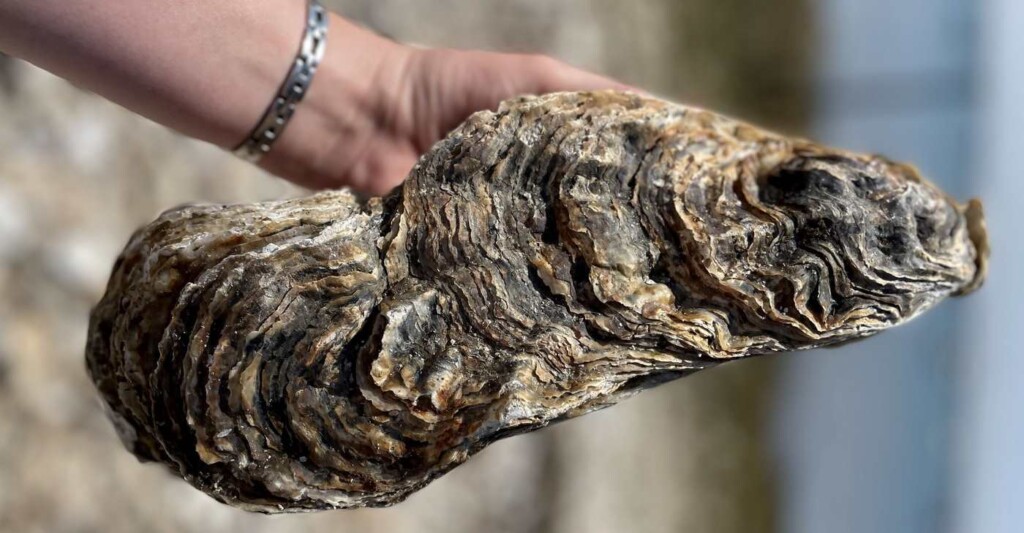
The boss of a seafood delicacy business has spoken of the shock he experienced harvesting a monster oyster as big as a newborn baby.
Tom Haward said he was fascinated after his company retrieved the huge mollusk, weighing 5.5lbs (2.5kg) along the coast of Mersea Island, Essex.
Mr. Haward estimates the 12 inches long and five inches wide oyster is 20 years old which makes it considerably rare as they usually only live for around six years in harvested waters.
“My first thought was ‘flipping heck’. We work with oysters all the time and see thousands upon thousands a day, but to see one like that, it was fascinating,” Mr. Haward said. “You could see the growth lines on it, just like a tree. It’s very intriguing.”
Richard Haward’s Oysters, founded in 1769, harvests around a million mollusks a year but Mr. Haward said this one was the largest he’d seen.
Positing how an oyster could live so long, the oysterman said that with 14 miles of oyster reefs, it’s always possible for an individual to be looked over.
“Some can be left growing as they keep getting missed and then they can end up around 20 years old,” he said.
Unlike other delicacies, size doesn’t confer special treatment, and if the oyster does make it to their market stall, it would be sold according to the weight of its meat, putting it at about $12.00.
A MOMENT OF APPRECIATION: How an Oyster Can Form a Perfectly Symmetrical Pearl – Better Than We Humans, With All Our Technology
However Mr. Haward said he may put this special find up for auction with any proceeds going as a donation to a lifeboat charity.
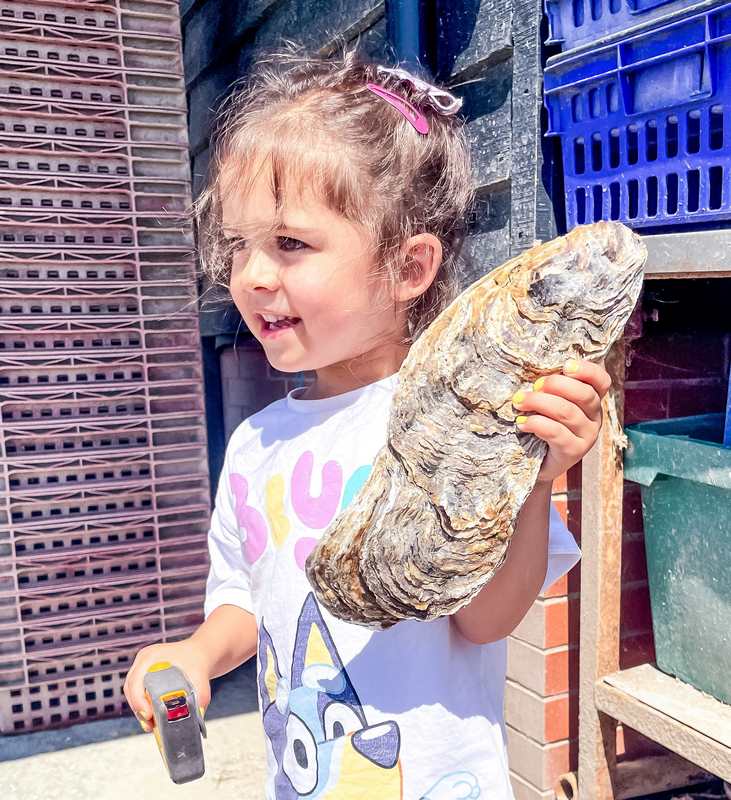
The eighth-generation oysterman joked that the seafood delicacy weighed about the same as his daughter Autumn when she was born.
“She weighed about 6lbs, this one was 5.5lbs. Autumn loves the sea so she could be the ninth generation of Richard Haward’s Oysters,” he told the British news source SWNS.
MORE RECORD-BREAKERS: World’s Largest Genome Discovered in a Tiny Fern: ‘Breaks all records’
“We’ve been doing this for 300 years and it’s still as exciting for us as it was back then.”
The oyster is 1.5 inches (4cm) short of the largest oyster recorded by the Guinness World Records, discovered in Denmark at 13.97 inches long.
SHARE This Amazing Ocean Oddity With Your Coastal Friends…
Stunning Tang Dynasty Mural Unearthed in China Portrays a ‘Westerner’ with Blonde Hair

In north-central China, roadwork near the city of Taiyuan uncovered a tomb dating to the Tang Dynasty that is turning heads for its remarkably preserved collection of murals depicting daily life.
One might imagine such a tomb decorated with images of dragons among heavenly palaces resting on clouds—depicting a glorious afterlife, but this tomb shows a series of pictures of household chores, and a glimpse of the Silk Road in the form of a foreigner.
Discovered in 2018 on a hill slope alongside the old Jin Ci West Central Ring Road in Taiyuan city, the tomb consists of a brick chamber, entranceway, and corridor, and first welcomed its owners into the embrace of the Earth around 736 CE during the Tang Dynasty.
The Tang saw the Chinese Empire reach its greatest territorial extent, and become a cosmopolitan realm of magnificence, luxury, and highly developed in arts, letters, and commerce. Several of the most famous rulers of China date to this period, including the concubine turned Empress Wu Zetian, and the domineering Emperor Taizong, who created much of the control and prosperity the dynasty enjoyed.
On the tomb’s three walls and four pyramidal ceiling faces, scenes from Tang life are depicted that include men and women stepping on and scooping rice, grinding grain in a mill, making noodles, bathing, and using a strange contraption mounted in an orange tree to draw water from a well.
On another panel is the depiction of a “Westerner” which for the Tang Chinese meant someone from what is known in the West as the Tarim Basin, or perhaps even further into Transoxiana—the two regions crossed by traders on the Silk Road before reaching the ‘Jade Gate’ and the Gansu Corridor into China proper.
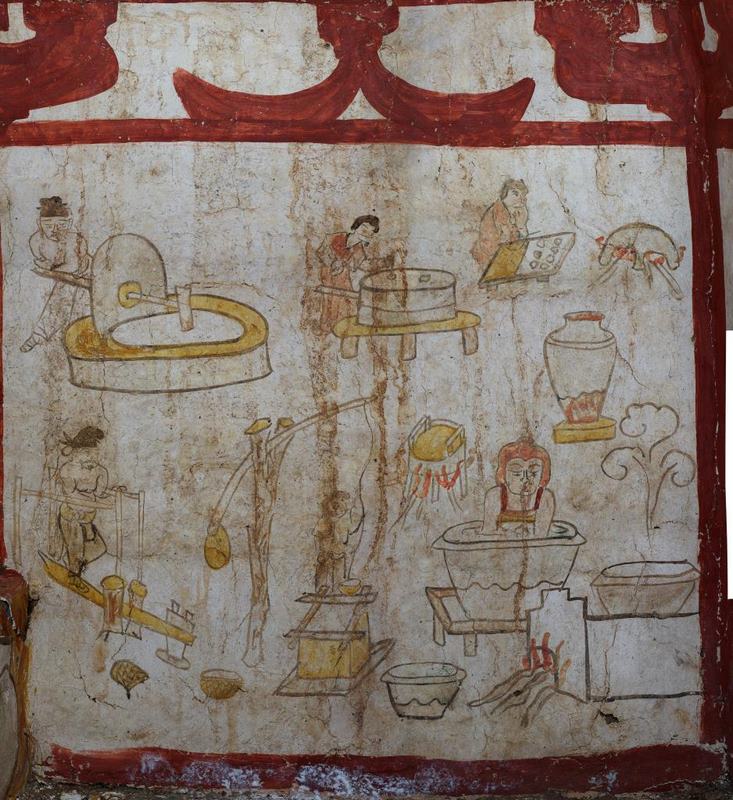

The Westerner is depicted with blonde hair holding the reigns of an Asian camel and several horses, and was likely a Sogdian—a trading people who flourished and declined with the rise and fall of the fortunes along the Silk Road. He’s unlikely to be a Turk, as the Tang Emperor warred fiercely with several Turkish khagans over the dynasty’s history.
NEWS FROM THE SILK ROAD: 2,000-year-old Gold Jewelry from Mysterious Central Asian Culture Discovered in Kazakhstan
Other panels show what is probably the tomb’s owners, a man in his sixties and a woman, under trees according to one of the oldest established Chinese art styles known as “figure under a tree” which dates to the Han Dynasty of the 2nd century BCE to the third century CE.
MORE CHINESE TOMBS: Extremely Elaborate 2,200-Year-old Tomb Discovered That May Have Belonged to a King–‘Most Complex Structure of its Kind’
The final set of panels shows yellow-robed swordbearers at the entrance of the tomb, alongside doormen holding the coffin in their hands and standing in positions of welcome. The ceiling is decorated with mythical beasts, likely dragons or phoenixes.
SHARE This Amazing Ancient Artwork With Your Friends Who Love History…
“Buried talent is the sunken rock on which most lives strike and flounder.” – Frederick William Faber
Quote of the Day: “Buried talent is the sunken rock on which most lives strike and flounder.” – Frederick William Faber
Photo by: ©MCC
With a new inspirational quote every day, atop the perfect photo—collected and archived on our Quote of the Day page—why not bookmark GNN.org for a daily uplift?

Good News in History, July 24
6 years ago today, the 10 millionth MINI automobile was sold; in the year of its 60th anniversary no less. To celebrate the milestone, MINI shared the stories from 60 owners of 60 cars, one from each year of production across the MINI digital channels throughout 2018. “The stories from owners around the UK show the love they have for their cars and the important part they have played in so many people’s lives,” a press release stated. READ a brief synopsis of the brand’s history… (2018)
Primary Cause of Lupus Discovered–And a Possible Way to Reverse It

A team of scientists from Northwestern Medicine and Brigham and Women’s Hospital have identified the cause of lupus, a devastating autoimmune disease that affects 1.5 million Americans.
In doing so they also believe they’ve found a cure, or at least a more sophisticated treatment, and are currently working on developing a pharmacologic method of delivering the potential cure-like molecule.
Lupus erythematosus, to use its full name, involves the body’s immune system attacking its own native cells, causing a variety of skin complications, while also potentially life-threatening damage to the heart, kidney, and brain. The cause of lupus isn’t well understood, and the scientists at Northwestern criticized existing treatments as “blunt instruments.”
The researchers first studied lupus patients and found that those with the disease had higher levels of an infection-fighting protein called interferon and not enough aryl hydrocarbon receptor (AHR), which regulates how the body responds to infection.
“Up until this point, all therapy for lupus is a blunt instrument. It’s broad immunosuppression,” said co-corresponding author Dr. Jaehyuk Choi, associate professor of dermatology at Northwestern University. “By identifying a cause for this disease, we have found a potential cure that will not have the side effects of current therapies.”
His coauthor Dr. Deepak Rao, a rheumatologist at Brigham and Women’s Hospital, explains the cure acts as an adjustment.
“We’ve identified a fundamental imbalance in the immune responses that patients with lupus make, and we’ve defined specific mediators that can correct this imbalance to dampen the pathologic autoimmune response,” said co-corresponding author Dr. Deepak Rao.
YOU MAY ALSO LIKE: Overlooked Drug Proven to Be Superior Treatment for Crohn’s Disease–Helping Patients Avoid Surgery
Rao and Choi, along with the rest of their team aim to develop medications to activate the AHR pathway. When this pathway is insufficient, it results in too many immune cells that promote the production of disease-causing autoantibodies.
Northwestern press reports that in order to show how this discovery can be leveraged for treatments, the investigators returned the AHR-activating molecules to blood samples from lupus patients. This seemed to reprogram these lupus-causing cells into a type of cell that may promote wound healing from the damage caused by this autoimmune disease.
MORE AUTOIMMUNE DISEASE TREATMENTS: New Simple Therapy Offers Potentially Groundbreaking Treatment Option for ALS and Other Autoimmune Diseases
“We found that if we either activate the AHR pathway with small molecule activators or limit the pathologically excessive interferon in the blood, we can reduce the number of these disease-causing cells,” said Choi. “If these effects are durable, this may be a potential cure.”
ALERT Social Media Of This Potential Cure Now…
Baby Bird Rescued in Texas Wrapped in a Warm Tortilla Until Wildlife Experts Arrived
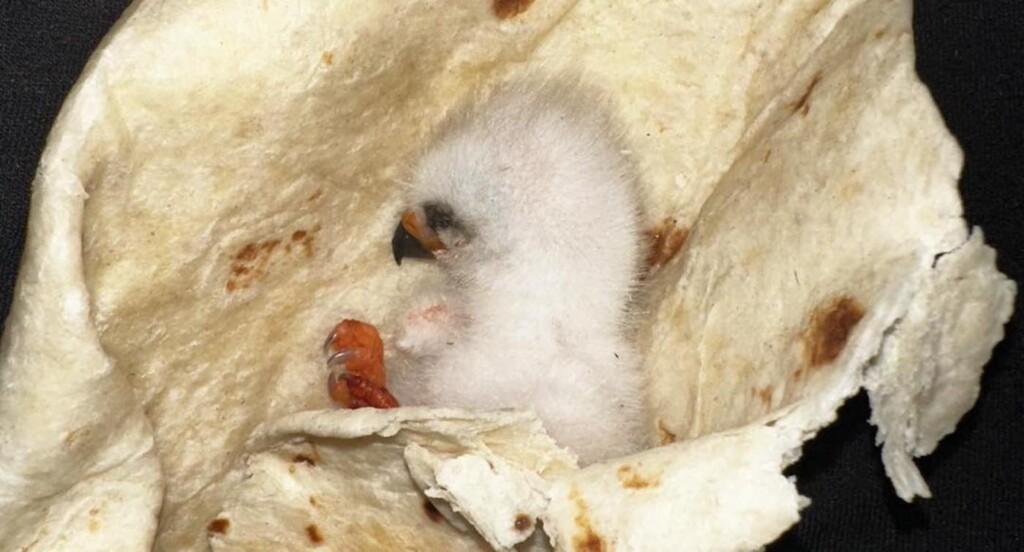
Being that it took place in America, as far as volunteers at the Wild West Wildlife Rehabilitation Center were concerned it was a story that could only happen in Texas.
A family in the north Texas city of Amarillo found a baby bird lying cold and abandoned on the ground in their yard during a swim party and barbeque.
The mother acted fast, tossing a tortilla on the stove before using it like a warm blanket to scoop up the chick.
Afterwards the WWWRC was alerted by the family that they had found what they thought was an owlet, but what turned out to be a Mississippi kite.
“Undoubtedly, it was an inventive method to keep the baby warm, and surprisingly, it was effective,” the wildlife center said in a Facebook post. “Wildlife rescue is always filled with lively and unexpected moments.”
The young bird is doing well and has since been given the name Taquito.
The WWWRC found the concept of a tortilla blanket irresistible charming (and surprisingly effective) and have begun selling custom t-shirts and hoodies to raise money for their operations featuring a graphic of a baby bird wrapped snuggly in a tortilla with the caption “Tortillas Save Lives.”
SIMILAR STORIES OF RESCUE: Quick-Thinking Flight Attendant and Passengers Save 6 Flamingo Eggs Aboard Flight
In the swarm of Facebook comments that followed the post, the tortilla mom revealed herself: Katie Lasher Adlong, who was praised with over 170 replies to her announcement.
“You’re a brilliant momma! Would have loved to see the lightbulb moment of ‘how am I gonna keep this baby safe and warm?'” one commenter said.
OTHER QUICK THINKERS: Watch Quick-Thinking Kayakers Save Pair of Rare Eagles Drowning in the Danube River
If you are short on thematic t-shirts and in the mood to support a great cause, WWWRC is swamped with injured birds from the effects of Hurricane Beryl, and they need to raise thousands to ensure each one gets appropriate medical care.
SHARE This Hillarious But Also Brilliant Quick Thinking Down In Texas…
Man Traveling the Width of Scotland in a ‘Bicycle Canoe’ Entirely Made by Hand

A man is preparing to travel the width of Scotland and back again in a bicycle canoe built by hand according to the time-honored British tradition of performing adventurous feats for charity.
The 36-year-old spent two months building his unique contraption, which has been dubbed Pedal Paddle, and will see him take on over 150 miles of land and sea.
Starting from Fort William, Ben Kilner will paddle to Inverness along the Caledonian Canal before turning around and cycling back on land along the Great Glen Way.
He aims to raise £2,500 for the charity A Leg To Stand On, which provides prosthetic limbs for children in developing countries across the world. He also hopes to inspire people to go outside and explore the world.
The idea was born after Kilner, who previously paddled down the River Thames in a hand-built canoe, was left unable to walk for several days after a camping trip.
“It was deeply upsetting and highlighted how much I rely on my mobility and how much we take it for granted,” said Kilner, from England’s East Sussex.
“The canoe is a skin-on-frame canoe made from Douglas fir and steam-bent green oak with a ballistic nylon skin stretched over it,” said Kilner in a TikTok video announcing his voyage by paddling the strange machine right into a lake. “The reason for going with that design was because it is super lightweight and also something I can build myself relatively easily.”
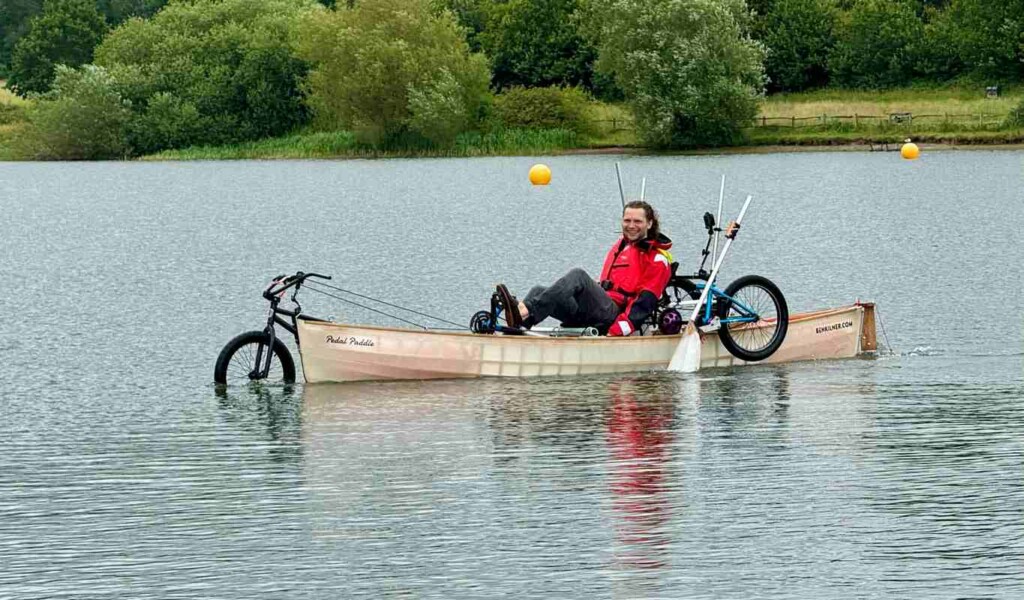
The challenge is expected to take around nine days, with Kilner spending his evenings and nights camping.
THE TIME-HONORED TRADITION: British Man Finishes His Run Across Africa: 385 Marathons in 352 days
“The biggest challenge will be the wind and stability. I’m sat quite high up along with the Pedal Paddle bike mechanism, so it’s pretty tippy. I think stability will be a challenge,” he added.
OTHER DIY INSPIRATION: Man Builds an Electricity-Generating Windmill in His Own Garden
“I’ll be doing daily updates on Facebook, Instagram, and TikTok as I’m going on the journey, and people can follow along. I’m excited to see the grand magnitude of Loch Ness and the Great Glen and to immerse myself in that.”
To find out more about the fundraiser or to donate, go to www.benkilner.com
WATCH The mad machine take to the water…
@ben_kilner Can’t wait to get going 😬🦆🚴♂️🛶🚀🚀🚀 Link to the donations page is in my bio or head to benkilner.com ❤️🙏 #seatoseaforcharity #benkilner #pedalpaddle #amphibious #bikeboat ♬ original sound - Ben Kilner
SHARE This Inspiring Cause And Outrageous Invention With Your Friends…
4,000-year-old Tablet Describes Ancient ‘Lunchables’ of Cheese and Meat Carried in a Box

At the ruined site of a 4,000-year-old civilization in Anatolia, clay tablets have been found documenting a mundane but nonetheless fascinating aspect of culture: packed lunches.
The tablet speaks specifically of a Kültepe Cheese that was part of daily life for the people in the region, who, according to the tablet, used to carry it around with them on journeys.
Located in central Turkey today, in a province (Kayseri) that bears an astonishingly similar name to the German word for cheese dairy (Käserei) the ruins of Kültepe are considered the birthplace of Anatolian civilization.
It was an important city for the Hittites: the premier Anatolian civilization of its time, and today is known as the site where the earliest definitive example of an Indo-European language was written: in the form of Hittite, the loan words from which are mixed into Assyrian and Acadian cuneiform on the 20,000 tablets located at the city.
Professor Fikri Kulakoğlu, an archaeologist working on the site, which has been under excavation and study for 76 years, explained to Hurriyet Daily that the cheese would have been essential for life in the region.
“Four thousand years ago there was a cheese called ‘Kaniş Cheese.’ We read from these tablets that they took this with them,” Kulakoğlu told the Daily. “Obviously, whatever is in today’s geography, we see the same products in a similar way 4 thousand years ago.”
SIMILAR NEAR EAST DINING HABITS: 5,000 Year-Old Tavern Found in Iraq
“People took this cheese with them while traveling,” he added. “People at that time took boxed, sliced, and dried meat with them on their journeys. Even today, it is similar to preparing a normal sandwich in today’s conditions.”
Today, “pastırma” a spiced dry meat, is still a traditional foodstuff to carry on one’s person in the region, and Kulakoğlu stresses how there is no reason to believe the continuity connecting Hittite habits and today’s grab-and-go food culture has been interrupted.
CHEESE NEWS TODAY: First Ever Cheese Museum Opens in Paris: ‘It’s Gouda Brie a Delicious Visit’
It’s not the oldest example of cheesemaking in the world, as pottery found in Poland shows how comparatively primitive Neolithic cultures in Northern Europe were making cheese to circumvent lactose intolerance, or so it’s hypothesized, 2,000 years earlier than the Kaniş Cheese tablets.
KEEP The Cheese Wheel Of History Turning With Your Friends…
“Art teaches nothing, except the significance of life.” – Michael Korda
Quote of the Day: “Art teaches nothing, except the significance of life.” – Michael Korda
Photo by: Hayes Potter
With a new inspirational quote every day, atop the perfect photo—collected and archived on our Quote of the Day page—why not bookmark GNN.org for a daily uplift?

Good News in History, July 23
4 years ago today, China launched the Mission Tianwen-1, or “Heavenly Questions” to Mars, becoming the second nation to have a presence there. It was the first time a nation-state had ever launched an orbiter, lander, and rover all in the same mission, and the Chinese space program became the first in the world to have all three of these machines successfully deploy on Mars on the first try, as well as the first to get them all right at the same time. READ MORE about the Chinese space program… (2020)

The Chinese are a society that is intensely focused on the stars: the organization of the heavenly branches and stems guide their calendars, auspicious and inauspicious signs, and even their language.
The Chinese government sees space exploration as both symbol and substance, believing as NASA does that investments into space science and exploration can come good by developing advanced and useful technology for Earthbound life.
By late 2021, the rover Zhurong, named after a mythical fire god, had already accomplished its primary mission goal and continued to explore the Utopia Planitia plain, providing substantive evidence to support the hypothesis that this part of Mars was an ocean.
Zhurong gathered data on the Martian weather, registering 37 mph winds that blew close to true south from the northern summer solstice, shifting to southeastwards until the northern fall equinox.
MORE Good News on this Day:
- The ice cream cone was invented by Charles E. Menches on the occasion of the Louisiana Purchase Exposition in St. Louis, Missouri (1904)
- The first successful liver transplant was performed by Dr. Thomas Starzl at the University of Colorado on 19-month-old Julie Rodriguez, a cancer patient who lived for 400 days with her new liver (1967)
- Democracy returned to Greece as military factions, which forced him out, invited the former prime minister Constantine Karamanlis to return and huge crowds gathered to greet him at the Athens airport as jubilation arose in the streets (1974)
- More than 25 countries joined together to end commercial whaling following more than a decade of public pressure, with major whaling forces like the US becoming strong proponents of the anti-whaling convention (1982)
On this day, 132 years ago, Emperor Haile Selassie was born. One of the seminal figures in Ethiopian history, he was a member of the Menelik dynasty that traced its ancestry to the union of King Solomon and the Queen of Sheba. As emperor of Ethiopia, he introduced the first written constitution, abolished slavery, presided over the formation of the Organization of African Unity, the precursor of the African Union, and served as its first chairman.

He is believed to have been the reincarnation of Christ on earth in the eyes of the Rastafarian movement, and he is referred to as “Jah” or “Jah Rastafari.” When he eventually traveled to Jamaica to address the growing religious movement, his plane landed on a runway of covered people and couldn’t leave the airplane.
The leader of the Rastafarians was invited up to “negotiate the Emperor’s disembarking” which was eventually done, marking the day as “Grounation Day,” the second holiest day on the Rasta calendar.
Rita Marley, Bob Marley’s wife, supposedly saw the marks on his hands from where his previous form had been nailed to the crucifix by the Romans, hence Bob’s transition to Rastafarianism and the growth of its notoriety thereafter. Marley’s song Iron Lion Zion is about Haile Selassie. (1892)
Happy 53rd Birthday to the amazing musician and singer Alison Krauss, who has won more Grammys than almost anyone.
A teenage prodigy in Decatur, Illinois, she was attracted to bluegrass music and was winning contests at age 10—and at 16 showed off her extraordinary fiddle playing on a debut album with a major label. Her soundtrack performance for O Brother, Where Art Thou? was credited with helping renew Americans’ interest in bluegrass music. As of 2019, she had won 27 Grammy Awards from 42 nominations, ranking her fourth behind Beyoncé, Quincy Jones, and classical conductor Georg Solti for most wins overall.

Her collaboration with Robert Plant, Raising Sand, was certified platinum and won five Grammys, including Album and Record of the Year. She’s sold more than 12 million records to date and will be inducted in 2021 to the Bluegrass Music Hall of Fame.
Krauss has teamed up with many country musicians, but also across genres with stars like Dolly Parton, Taylor Swift, The Chieftains, James Taylor, Yo-Yo Ma, Cyndi Lauper, Heart, and Phish. Check out her fiddle skills in Man of Constant Sorrow on YouTube, playing with her longtime band, Union Station—and WATCH her perform the ballad, When You Say Nothing At All... (1971)
Happy Birthday to Harry Potter—the actor Daniel Radcliffe—who turns 35 years old today.

At age 11, he was cast as Potter in the debut film Harry Potter and the Philosopher’s Stone—and he learned the life-changing news while in the bathtub chatting with his mum in London. While starring in all 8 films of the series for 10 years, until 2011, he became one of the highest-paid actors in the world, and earned critical acclaim in his role as the young wizard.
Later, he portrayed Allen Ginsberg, the famed beat poet, in the 2013 independent film Kill Your Darlings, and won praise in the Broadway musical revival of How to Succeed in Business Without Really Trying. He recently co-starred with Steve Buscemi (who plays God) in a TBS comedy series Miracle Workers about working in heaven as a low-level angel responsible for handling all of humanity’s prayers.
And, on this day in 1983, an Air Canada 767 jet ran out of fuel at 41,000 feet elevation but, thanks to the pilot’s experience in flying gliders, it made a miraculous deadstick landing at Gimli, Manitoba, with no injuries to the 61 passengers or the festival goers attending a drag-racing event at the closed air force base where Captain Bob Pearson, 47, had planned to land. The plane was dubbed ‘The Gimli Glider’.
This TV show segment from The National produced five years ago on the 30th anniversary didn’t include some of the juicier details about the pilots’ calculations and the landing, which you can read on Wikipedia. They encountered good fortune when the nose landing-gear did not stay open and they were able to use a guardrail that had been installed down the center of the old runway to produce added friction for stopping the plane’s momentum.
WATCH the dramatic video from CBC News…
Also on this day 24 years ago, Tiger Woods became the youngest golfer to win a complete Grand Slam. At age 24, he held all four modern major championships simultaneously — the U.S. Open, The British Open Championship, the PGA Championship, and the Masters. He won the British Open that year at St. Andrews, with the best score ever recorded—19 under par.

His father Earl, a former Vietnam War lieutenant colonel and a formidable amateur golfer, first lost to his son in a golf match when Tiger was 11 years years old. Even with his dad trying his best, he lost to the boy every time after that.
After personal problems and a divorce, he dropped to 58th in the rankings, but in 2013 he climbed back to #1. An injury followed, but with back surgery Woods recovered to win a first major in 11 years at the 2019 Masters. (2000)
SHARE the Milestones, Memories, and Music…
CRISPR Identifies Commonly Available Drug That Works as Cobra Venom Antidote


In a scientific paper demonstrating multiple breakthroughs, scientists at Sydney and Liverpool have identified a commonly available blood thinner that doubles as an antidote to cobra venom.
The study relied on CRISPR gene modification technology to identify cells immune to snake venom and use them as case studies to figure out what would be the best mechanism for preventing necrosis from snake bites.
The authors describe snake bites in general as “the deadliest neglected tropical disease” and report that around 140,000 people every year die from them, with another 400,000 permanently wounded.
Snake venom comes in different forms. Cobra venom attacks cells directly causing necrosis, but also attacks the nervous system and can affect the heart and brain.
Antivenom is typically about 7 times as expensive as the average daily wage in countries where cobra bites are the highest, and many pharma companies will simply discontinue the products for this reason.
By examining the effect of cobra venom, what study author Professor Greg Heely refers to as a “three-finger toxin,” on human cells, he and his team found a cell pathway conserved in all known animal species that produces the related molecules heparan and heparin, the latter being a used as a blood thinner.
“Heparin is inexpensive, ubiquitous, and a World Health Organization-listed Essential Medicine. After successful human trials, it could be rolled out relatively quickly to become a cheap, safe, and effective drug for treating cobra bites,” says Ph.D. student and lead author, Tian Du, who like Professor Neely, resides at the University of Sydney, working in functional genomics.
Heparin and heparan are both targets of cobra venom, with heparan found on the cell surface and heparin being released during an immune response. Their similar structure means the venom can bind to both, and the “heparan/heparin sulfate biosynthesis pathway” was often the most heavily targeted component by the venom as a means to infiltrate cells, with 7 out of 11 components in the pathway attacked by the venom of the red spitting cobra, and 8 out of 11 by the venom of the black-necked spitting cobra.
The team used this knowledge to turn the heparin drug into an antidote that can stop necrosis in human cells and mice by flooding the bite zone with decoy molecules. The venom rapidly attacks the exogenous heparin, leaving the endogenous heparin and the cells containing it, intact.
OTHER SIMILAR NEGLECTED MEDICINE: FDA Approves New Drug for A Timeless Illness–Frostbite–to Save Fingers and Toes from Amputation
Cobras are part of the Elapidae family of snakes which include sea snakes, mambas, and coral snakes. In some parts of Asia and Africa, cobras are responsible for more bite deaths and amputations than any other group.
In an interesting secondary discovery, the team hypothesized how their method could be used to find other use cases for antivenoms. In a video explainer, Professor Neely says that there aren’t many different kinds of venom across the animal kingdom, and finding a way to crack the code of one offers the chance to develop antivenoms much more rapidly.
MORE BREAKTHROUGH MEDICINES: Scientists Find Potential Universal Anti-Venom to Treat Snakebites, from Kraits to King Cobras.
The three-finger toxins present in cobra venom are also found in the terribly toxic blue bottle jellyfish of Australia, which the team says is next on their list for antivenom research.
It was hypothesized when CRISPR first entered the public zeitgeist that it would be monopolized by wealthy industrialized nations to create a slew of aesthetic products and treatments to enhance beauty or longevity. It’s inspiring to see CRISPR be used directly for the benefit of the poorest and most vulnerable members of the world.
SHARE This Amazing Discovery And The Thousands Of Lives It Could Save…






















